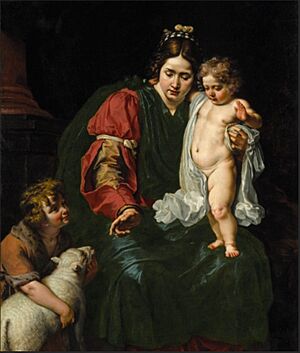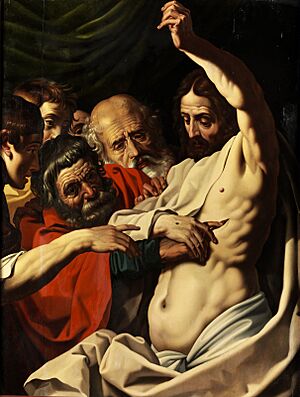Abraham Janssens facts for kids
Abraham Janssens I (born around 1575, died 1632) was a famous painter from Flanders (which is now part of Belgium). He was best known for his big paintings about religion and old stories (myths). His art was inspired by another famous painter named Caravaggio. Before Rubens came back from Italy, Janssens was considered the top history painter in Flanders.
Contents
Life of Abraham Janssens
Abraham Janssens was born in Antwerp, a city in what is now Belgium. His parents were Jan Janssens and Roelofken van Huysen. Experts used to think he was born in 1567, but now they believe he was born in 1575.
Janssens started learning to paint with Jan Snellinck in 1585. He joined the local Guild of Saint Luke, which was like a club or union for artists.
He traveled to Italy and lived in Rome from 1597 to 1602. When he came back to Antwerp, he became a master painter in the Guild in 1601-1602.
On May 1, 1602, he married Sara Goetkint. They had eight children, and five of them were still alive when Sara passed away. One of their daughters, Maria Anna, also became a painter and married Jan Brueghel the Younger.
In 1607, Janssens became the leader (dean) of the Antwerp Guild of St Luke. This was a very important time for him, as he started getting big painting jobs. Until Rubens returned to Antwerp in 1608, Janssens was seen as one of the best history painters. After Rubens became very popular for large church paintings, Janssens looked for commissions from other cities.
In 1610, Janssens joined the Confrerie of Romanists. This was a group of artists and thinkers in Antwerp who had all visited Rome. Being part of this group helped him meet important people who might want to buy his art.
Abraham Janssens passed away in Antwerp. Some of his students who became famous painters include Giovanni di Filippo del Campo, Michele Desubleo, Nicolas Régnier, Gerard Seghers, Theodoor Rombouts, and his own son, Abraham Janssens II.
Artistic Style and Works
What Janssens Painted
Janssens painted many different kinds of pictures. He created scenes from the Bible, stories from ancient myths, and allegories (paintings that use symbols to represent ideas). Sometimes, he also painted portraits of people.
He also made paintings that showed everyday life, like scenes about the five senses or the seven deadly sins.
Janssens sometimes signed his paintings "Janssens van Nuyssen." People think he added "van Nuyssen" (his mother's family name) to stand out, because "Janssens" was a very common name in the 1600s.
It's hard to know the exact order of Janssens' paintings because he didn't often put dates on them.
Early Paintings
His first paintings were in a style called late 16th-century Mannerism. This style often used unusual designs and bright, spread-out colors.
For example, his painting Diana and Callisto from 1601 (Museum of Fine Arts, Budapest) shows this early style. It was more influenced by Dutch painters than by Italian art at that time. However, like his later works, it did use ideas from ancient Roman and Greek sculptures.
After returning to Antwerp in 1602, Janssens' art started to show the strong influence of the Italian painter Raphael. You can see this in his painting Mount Olympus (Alte Pinakothek, Munich). This work combines his study of ancient art and the artist Michelangelo.
Around 1606, Janssens' style changed again. He began to be influenced by Caravaggio, another famous Italian painter. This new style used strong contrasts of light and shadow. He painted in this style for about five or six years.
One of his most important paintings from this time is Scaldis and Antverpia (also called Allegory of the Scheldt) from 1609 (Royal Museum of Fine Arts Antwerp). The city of Antwerp asked him to paint this for their city hall. It celebrated the Twelve Years' Truce (a peace agreement) signed in 1609. The painting shows the river Scheldt (Scaldis) and the city of Antwerp (Antverpia), hoping for new wealth and trade.
This painting shows Janssens at his best. The figure of Scaldis was inspired by an ancient statue. The way the painting is put together reminds some people of Michelangelo's The Creation of Adam. This work shows how Janssens' style became more classical and beautiful. The influence of Caravaggio is clear in the strong contrasts of light and dark (chiaroscuro), which create a powerful feeling.
Other paintings from this period include Allegory of the burdens of time (Royal Museums of Fine Arts of Belgium, 1609) and Peace and plenty (Wolverhampton Art Gallery, 1614). The painting The dead Christ in the tomb with two angels (Metropolitan Museum of Art, around 1610) was likely made for a church altar.
Later Paintings
After 1612, Janssens' painting style changed again. Like many other artists in Antwerp, he was strongly influenced by the free and flowing style of Peter Paul Rubens.
Janssens' paintings of half-length figures (showing only the upper body) were still seen as new and important. His religious paintings were also very popular. A good example is The crucifixion (Musée des beaux-arts de Valenciennes, around 1620). In this painting, the figures look like sculptures, giving them a timeless and powerful feeling.
Images for kids
See also
 In Spanish: Abraham Janssens para niños
In Spanish: Abraham Janssens para niños





